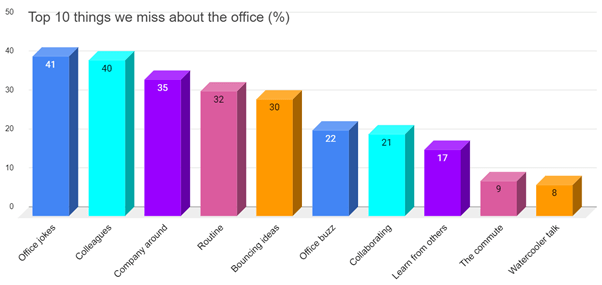Following the 2020 “sea change”, to working from home, most organisations and individuals have settled into their home working routines. This short series of articles highlights ways to identify friction points, to prevent or reduce conflict with colleagues, wherever they might be.
Home working challenges often lead to conflict. Significant improvement can be found through a sequence of key questions. First, identify the source of your struggle – Does the challenge arise from:
A. my own work space (eg sharing wifi, child care impact) OR
B. my organisation or remote colleagues (eg. difficulty accessing a manager, feeling out of depth with new software)
In Blog#1 we looked at ‘A. My own work space’. Today we consider how to reduce conflict with colleagues:
My organisation or remote colleagues
The loss of the “water-cooler chat” has been noted as one distinct disadvantage of working from home.
Source: FlyResearch for Vodafone
The opportunity to check in or to informally address an issue has been difficult to replace in the online environment. When you don’t have a chance to clear up these matters they can fester and have a negative impact on relationships at work and at home. If you are experiencing friction with a colleague this sequence of questions can help you to unlock improvements.
Does the challenge arise from:
- tools or skills (eg. better software products or training needed to do tasks well)
- communication (eg. difficulty getting access to or input from a colleague; inconsistent scheduling/monitoring)
- behaviours (action/omissions of an individual or group)
The last item, “Behaviours” will be the topic of blog #3 as there is a lot to cover. This blog #2 looks at Tools/Skills and Communication.
For many people, moving to working from home alters access to the tools used to do everyday tasks. Even something simple like use of Microsoft 365 package online vs desktop can require an upgrade in licences. Access to office-based information may also require an extension of technology for staff via a VPN etc. At a time where organisations are under pressure for both time and income this can mean things get missed or difficult decisions have to be made in a rush. Mis-matched expectations about these aspects are a common cause of friction and sometimes conflict. Ask yourself the following sequence of questions:
Tools/skills
Q1-what is needed? (new package, upgrade/licence, training, etc). Possibly “who can help me answer this”?
Q2-who is responsible to sign off (pay for) and set up this item?
Q3-can I make this easier? If you provide options, cost variables, even check if there is covid-19 funding available to pay, your manager has less to do and is more likely to agree to your request or give clear reasons if any aspect of the proposal is an issue.
Communication
Q1-what am I finding difficult, specifically? Is it something practical (eg. email tennis when you’d rather pick up the phone), personal (eg. a particular tone or mindset you feel you are getting from a colleague), something system-based (eg the way hours/work is monitored)
Q2-what am I asking for? a small change (eg a weekly check in by phone), a big change (eg. a different allocation of tasks), or more information (eg why performance is assessed in a particular way)
Q3-who can address this with/for me? do I need to plan a conversation with a colleague or manager, would it help to have someone else present?
See tips to plan that conversation later in this blog series
The question sequence is a simplification of each situation. In our experience, there are always multiple factors involved. When someone is feeling frustrated, angry, upset or overwhelmed it can be hard to ‘see the wood for the trees’. Going through the question sequences will enable you to start to break down the situation.
To put this into a visual context, when someone is dealing with a massively knotted ball of twine, teasing out individual strings from that ball will gradually untangle it. Sometimes the individual can do this themselves; sometimes the support of a colleague or friend is needed; occasionally, (eg if it’s necessary to rebuild trust), external expertise is the answer – we can provide 1:1 advice sessions or facilitate discussions between two people or whole teams to enable unravelling of the threads.
We find that rebuilding from a position of mutual understanding, allows clients to create a customised, realistic platform. That gives them the best opportunity to maximise commitment, productivity and well-being for the individual staff and ultimately, the organisation.
Virtual ‘Water Cooler chat’ – new developments
For some workers – it may be as simple as encouraging their organisation to build in some online “water-cooler chat” ie. non-task-related team time. There is a lot of information supporting the business benefits of this time, including recent developments in the best ways to do this virtually. If you would like links to that information do get in touch with us.
Blog#3 in the series “Remote working – quick tips to reduce conflict” will look at “Behaviours” – the acts/omissions by colleagues that make your working life difficult…and how to address them”




